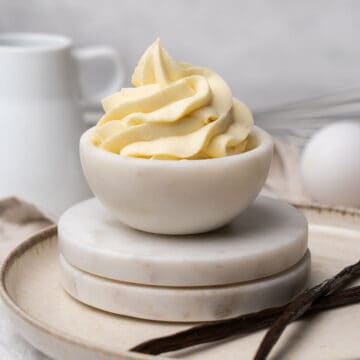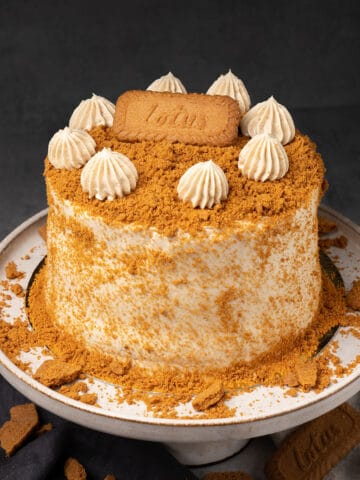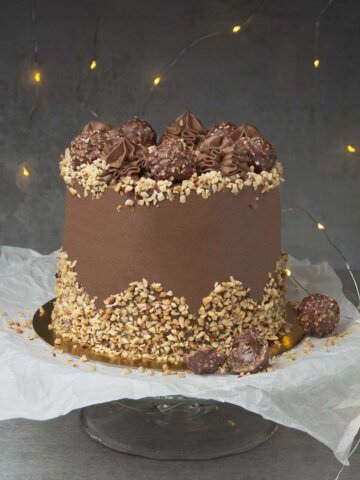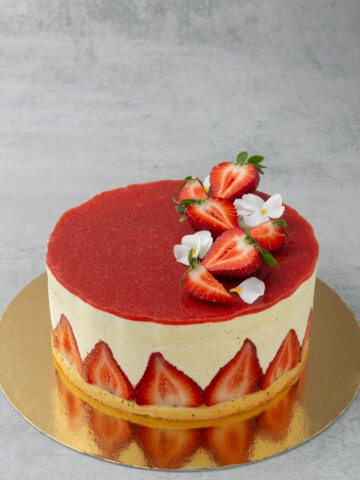With a rich and silky smooth custard-like character, this easy German Buttercream recipe (Crème Mousseline) is absolutely divine, my favorite buttercream frosting. It's composed of a simple pastry cream base that is enriched with butter, which is what makes it stand apart from more traditional sugar-heavy buttercreams. You can use Crème Mousseline on a variety of desserts from layer cakes and cupcakes to French macarons.

Jump to:
- 💡 What are the 5 types of buttercream?
- 5. German Buttercream
- 💡 What is German buttercream made of?
- 💡 Is Ermine frosting the same as German buttercream?
- 💡 Is German buttercream less sweet?
- 🌟 Why this is the best German buttercream frosting recipe
- 📝 Ingredient notes
- 👩🍳 How to make German buttercream
- ✨ What is German Buttercream used for
- 🎓 Expert tips
- ❓ German buttercream frosting FAQs
- 🍰 More frosting and filling recipes
- German buttercream (Crème Mousseline)
💡 What are the 5 types of buttercream?
Most people ask, what are the three types of buttercream? But there are actually more. So how many different types of buttercream frosting are there? Quite a few. When it comes to frosting and filling desserts you've got lots of choices! Here are the five most common.
1. American Buttercream (AMBC)
American Buttercream is the easiest to make and most commonly used type of frosting. It's very very sweet and is made by simply whipping butter and powdered sugar together, typically with a small amount of milk. American buttercream is fairly stable which makes it good for decorating. However, it is super sweet, less delicate, and less complex when it comes to the flavor profile.
2. Swiss Meringue Buttercream (SMBC)
Swiss Meringue Buttercream is a little less sweet and has more steps to make than American buttercream. As the name suggests Swiss Meringue buttercream has a Swiss meringue base, which makes it lighter and creamier. It's typically composed of egg whites and sugar cooked together over a double boiler and then whipped up with butter and a dash of salt and vanilla extract. It is super stable but you need to pay attention to the swiss meringue stage.
3. Italian Meringue Buttercream (IMBC)
Italian Meringue Buttercream uses the same ingredients and is somewhat similar to swiss meringue buttercream. But Italian Meringue Buttercream is sweetened with sugar syrup which makes it very stable but requires a little more technique especially when it comes to handling the sugar syrup and being accurate with its temperature.
4. French Buttercream
This one is light and smooth, a less-known buttercream, made with egg yolks (instead of egg white like the previous buttercream version), butter, and sugar syrup, similar to Italian meringue buttercream. French buttercream is a little more difficult to make and is naturally yellowish in color due to the egg yolk.
5. German Buttercream
Also called crème mousseline, it's basically the most delicious buttercream in my view, a different league from the rest. Cream mousseline is made of pastry cream and butter. German buttercream frosting has a lovely creamy texture, a superior custard-like taste profile, can be easily flavored, and most importantly not as sweet as the previous buttercream types.
It is used for French Classics such as Paris-Brest, Fraisier cake, but can be also flavored to make the most amazing Ferrero Rocher Cake or Lotus Biscoff Cake.
Making mousseline cream is also not hard at all but does require a few steps.
💡 What is German buttercream made of?
To begin, what is German buttercream? Also called Bavarian buttercream as well as mousseline cream, it's essentially a custard-based buttercream. You start with a pastry cream that is made with egg yolk, milk, and thickening ingredients such as cornstarch and flour. For more details please check my pastry cream recipe. Then, once the mixture comes to room temperature, it is whipped up with soft butter.
💡 Is Ermine frosting the same as German buttercream?
While these two frostings are similar, they are not the same. Ermine frosting is also called flour buttercream and has a pudding base. Basically, flour, milk, and sugar are cooked together to make ermine so no egg yolk is involved as in the German buttercream. German buttercream has a custard base that is similar to ermine but also egg yolk plays a key part.
💡 Is German buttercream less sweet?
Like most European-style frostings, custard buttercream is most definitely less sweet as well as both richer and more complex in flavor. It relies solely on its pastry cream base for all of its sweetness. So it's a fantastic option if you've ever wondered how do I make buttercream frosting for cakes less sweet!
🌟 Why this is the best German buttercream frosting recipe
- It's easy - How to make German buttercream frosting? It's simple! Even if you're new to baking you should have no problem and great success just make sure to follow the recipe and pay attention to the ingredients, measurements, and temperatures.
- The texture and taste is amazing - By using pastry cream as the base, which also makes it less sweet, this custard-like frosting has a lovely creamy and silky texture. So for example, when it comes to American buttercream vs German buttercream it's much more unique and complex.
- Versatile frosting - This delicious buttercream can be used as a filling as well as to frost cakes, cupcakes, and more. It can also be flavored with a variety of other ingredients such as Nutella, Biscoff spread, and peanut butter or even cocoa powder to make chocolate German buttercream.

📝 Ingredient notes

- Milk - Use whole milk for the creamiest texture.
- Sugar - White granulated sugar is all you need. And be sure to check out my sugar guide to learn about different types of sugar in baking.
- Egg - You only need the yolks of the eggs and they need to be at room temperature so that they blend properly with the other ingredients.
- Cornstarch - Used to add thickness to the texture of the frosting. Alternatively, check my cornstarch substitute article.
- Flour - Simple all-purpose flour is all you need. If you're interested in learning more about flour, please check out my flour guide.
- Vanilla - I like to use vanilla bean paste. However, pure vanilla extract is another option or why not make your own vanilla extract?
- Butter: Always use unsalted butter to control the level of salt. I also prefer using butter with an 82% fat content. For this recipe, the butter must be at room temperature. You can even make your own homemade butter.
🛒 You’ll find detailed measurements for all Ingredients in the printable version of the Recipe Card at the bottom of this post
👩🍳 How to make German buttercream
1. How to make pastry cream for the German buttercream
- Whisk the sugar and egg yolks together in a large bowl using a hand whisk for about 1-2 minutes until slightly fluffy.
- Whisk the cornstarch, flour, and vanilla bean paste into the egg yolk mixture until it's fully combined and it becomes a smooth paste.
- Bring the milk to a simmer over medium heat in a saucepan. Then remove it from the stove.
- Slowly pour the warm milk over the egg mixture while whisking vigorously.
- Pour the mixture into the saucepan and then cook over medium heat for 1-2 minutes to thicken.
- Strain the pastry cream to remove any lumps if necessary.
- Incorporate the soft room temperature butter in 3 stages using a rubber spatula. Each addition should be fully incorporated before adding the next.
- Transfer the pastry cream into a shallow bowl and cover the surface with plastic wrap so that skin won't form on top. Then allow it to cool to room temperature.
💡 Top Tip: As it thickens in the saucepan the cream may get lumpy at first, but just keep whisking and it will become smooth and glossy.

2. How to whip up the German buttercream
- The pastry cream and butter must be at room temperature to make the crème mousseline.
- Whip the softened butter for 1-2 minutes in a stand mixer fitted with a whisk attachment. Then add the pastry cream in 4 stages until the mixture reaches a fluffy but stable consistency. This will take about 1-2 minutes, be very careful not to over-whip.
- If the buttercream seems soft once it's made, just put it in the fridge to chill for a bit before using.
- Custard buttercream can be used fresh or stored in the refrigerator for 2-3 days.
💡 Top Tip: The cream will naturally set in the fridge due to its butter content (like any other buttercream) so if you want to pipe it, I recommend refrigerating the cream for no more than 1-2 hours.

✨ What is German Buttercream used for
This frosting can be used in combination with numerous other dessert recipes and flavored too. The possibilities are endless!
To get started, how to flavor German buttercream? It's actually pretty easy and done by simply whipping in your choice of flavorings into the butter and then adding the pastry cream to complete the crème mousseline recipe. Some of my favorite ways to flavor the buttercream are with ground cinnamon, cocoa powder, Biscoff butter, Nutella, peanut butter, and hazelnut praline.
And of course, you can use the frosting on cakes, cupcakes, cookies, or as filling for classic french pastry like choux! Just check out all these delicious recipes to use your wonderful and easy custard buttercream!
🎓 Expert tips
- Use high-quality ingredients for the best flavor. European butter with an 82% fat content, whole milk, good eggs, and top-quality vanilla makes all the difference in taste and texture.
- Allow the egg yolks to come to room temperature so that the pastry cream comes together properly.
- When adding the milk to the egg mixture of the pastry cream you must do it slowly while stirring constantly with a whisk.
- If necessary, strain any lumps out of the pastry cream after it has been thickened.
- The pastry cream and butter must be at room temperature before you can begin making the frosting.
- Do not over whip the frosting. Stop once it becomes fluffy, which takes about 1-2 minutes, or it can break and become runny.

❓ German buttercream frosting FAQs
Yes, German buttercream is a stable frosting however needs to be refrigerated. During the making, soft butter is incorporated into the pastry cream so naturally, the cream will be a bit soft straight when it is whipped up but it will set in the fridge.
Yes, German has lovely pipeable consistency. I recommend refrigerating the cream for no more than 1-2 hours as it will set in the fridge after making it more difficult to pipe.
If your German buttercream curdles or separates while making it, it is most probably due to pastry cream and butter not being at the same temperature. Use a hair drier and heat the side of the bowl while continuing to whip the mixture for another 12- minutes. This trick works in most cases.
Yes, it must be stored in the fridge and will keep for about 3-4 days. It can not be left out at room temperature meaning German buttercream is not appropriate if you want to store your cake in the heat for hours.
I don't recommend freezing this type of frosting as pastry cream does not freeze well at all.
🍰 More frosting and filling recipes

German buttercream (Crème Mousseline)
Ingredients
German buttercream
- 500 g (2 cups) Whole milk
- 100 g (½ cups) Granulated sugar
- 80 g Egg yolk approx. yolk of 4-5 eggs
- 25 g (⅕ cups) Corn starch
- 25 g (⅕ cups) All-purpose flour
- 1 Teaspoon Vanilla bean paste
- 50 g (¼ cups) Unsalted butter soft - will be mixed into pastry cream straight after it is cooked
- 150 g (¾ cups) Unsalted butter soft - will be whipped into the pastry cream to make the mousseline cream
US customary cup measurement is an indicative figure only. Measure the ingredients with a digital scale by weight (gram). Baking is art but also science which requires precision and accuracy.
Instructions
Start with the pastry cream
- In a large enough bowl with the help of a Hand whisk, whisk together sugar and egg yolk until slightly fluffy for about 1-2 minutes
- Mix in corn starch, flour, and vanilla until throughly incorporated and have a smooth paste
- Bring milk to simmer in a saucepan on medium heat then remove it from the stove.
- Pour the warm milk over the egg yolk mixture slowly while whisking vigorously with a Hand whisk.
- Pour the mixture back into the saucepan and cook on medium heat for a few minutes until it thickens. Concretely it is approximately 1 min after the first boil. It might get lumpy first, don't worry just keep whisking and the cream will get smooth and glossy
- If in doubt, strain the pastry cream for a lump free, creamy end result.
- Place the cream into a shallow bowl and cover the entire surface with plastic wrap to avoid skin forming on top. Let it come to room temperature
Make the mousseline cream
- Crème mousseline can be made with room temp pastry cream and room temp butter. Make sure everything is at room temp otherwise the mixture might curdle
- Once pastry cream cooled to room temp, prepare the mousseline cream by whipping room temp butter first for 1-2 minutes. Start adding in the room temp pastry cream in 4 stages until cream reaches a stable yet fluffy texture.
- Do not over whip the mixture as it can become runny or can curdle. The cream mgiht be on the soft side at this point due to the room temp butter used so place it back into the fridge for an hour to chill before using it.
- Store refrigerated for 2-3 days.
Notes
- Measure your ingredients with a Digital scale for accuracy
- Good quality butter and pure vanilla are the heart of making German buttercream. Use high-quality 82% fat content European butter and the best quality vanilla you can access. Whole milk is recommended to make the pastry cream as opposed to skinny milk.
- Fresh, farm eggs will provide bright yellow color cream, while cheaper supermarket eggs will result in a pale cream
- Make sure you read my Expert tips section above to maximize your success. A short recipe alone is not able to cover all the necessary details, and science behind baking.
- Use a good quality milk pan to cook pastry cream so the milk won´t burn in it
- While making Creme mousseline, it is crucial that both the pastry cream as well as the butter is at room temperature. If the mixture curdles while whipping, most probably the two were NOT at the same temperature. You can fix it by gently warming up the bowl with a hair dryer while the mixer is on at low speed.
- Do not walk away while whipping this cream, it will be ready in 1-2 minutes (depending on the power of your mixer) and can be easily overwhipped
- German buttercream is beautifully pipeable either straight after whipping it up or after one hour of chilling time. If kept longer in the fridge, the butter will fully solidify just like any other buttercream and you won´t be able to pipe it until bringing it back to somewhat room temperature


















Donna Hamilton
will this come out the same using a gluten free all purpose flour?
Katalin Nagy
I suggest using corn starch instead, it will work as 1:1 replacement.
Ann Lacey
Hey, so I just found your site… I guess google has been following my searches and put you on my homepage today! I looked at your site and read about you - I’m impressed. So, now I have put you on my search bar for new recipes. And then let me apologize for writing without making the recipe first… I hate when people do that.
Anyway, I am making 125 cupcakes today and frosting them tomorrow. They will be traveling 300 miles the following day and the wedding is the next night. They are leaving here in plastic cupcake boxes wrapped in Saran Wrap and surrounded by dry ice.
Because I have no control of the temperature after they leave here, or how long they will be left out during the wedding I am very worried about the frosting.
I made four different types of buttercream… Swiss Meringue (SugarGeek) , Ermine (Sugar Geek), Neoclassic Mousseline Buttercream (Rose Levy), and Mousseline Buttercream (Rose Levy).
If you are not familiar with the difference of Rose’s recipes… the Neoclassic has both sugar and corn syrup and uses egg yolks, while the Mousseline uses egg whites and just sugar. I prefer the Neoclassic, but as is with most of her recipes it’s a bit fussy.
So, after all this here’s my delemia. Which one is the most stable. I had read that Ermine was the most stable, but what a pain to re-emulsify. I assume because of the low sugar/high protein. Problem is that it’s so nice and white and has a different, distinct taste of vanilla Ice Cream or whipped cream; while the others are a pale/medium yellow (I did try to put violet food gel in to bring it down a bit, but it was not enough). They are all silky and delicious.
And then I see your recipe and now I’m wondering if I should make that! I can tell by the look, ingredients and recipe that it will be delicious and I love the vanilla beans (I ran out of paste the other day, but I have plenty of whole beans).
What I like about the Ermine is it’s so nice and white and has a different, distinct taste of vanilla Ice Cream or whipped cream; while the others are a pale/medium yellow (I did try to put violet food gel in to bring it down a bit, but it was not enough). The deepest yellow being the Neoclassic because of the yolks. I use Danish Creamery butter because it’s 85% butterfat and is paler than Kerrygold.
So, before I go on this crusade to put another buttercream on the board do you think this German Mousseline will hold up for three days… going from a refrigerator, to a cooler with dry ice, to God knows where?
I will eventually try this and rate it, I promise. And I am defiantly going to make that Christmas cake tree!
Katalin Nagy
Hey, thanks for your message and hope you will try some of my recipes soon. This is a fantastic frosting however do not recommend it for a wedding where you have no control of the temperature for hours and days, it is way too delicate for that.
John
Can this recipe be halved?
Katalin Nagy
Yes of course!